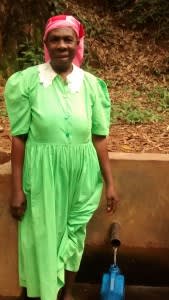This project is a part of our shared program with Western Water And Sanitation Forum (WEWASAFO). Our team is pleased to directly share the below report (edited for clarity, as needed).
Background Information
Mido Spring is located in Minyika Village, North Maragoli ward, Sabatia sub-county of Vihiga County. It is inhabited by the Maragoli sub-tribe of the Luhya Community. These people practice small-scale farming, planting a variety of food crops and teas as a cash crop. This spring serves 600 from 60 different households, whose people use water for drinking, household chores, and irrigation during the dry seasons. (Editor’s Note: While this many people may have access on any given day, realistically a single water source can only support a population of 350-500 people. This site would make a great location for a second project. To learn more, click here.)
The Current Source
Mido Spring is open to contamination and thus predisposes its users to waterborne diseases. "Sometimes, we do sacrifice [time] to get drinking water from a spring in our neighboring village four kilometers away taking us about two hours," says a local found fetching water at Mido Spring. This time searching for clean water is time lost that could have been used for other more productive activities.
Sanitation Situation
The community around Mido Spring is willing to provide the locally available materials needed for construction and to attend health and hygiene trainings. It was also noted that quite a few homes still do not have pit latrines, and other families are forced to share their sanitation facilities while others reportedly opt for open defecation. This open defication is exposing the entire community to fecal-oral diseases. "My neighbor has lived for decades with no pit latrine," a community member confides, "we are more than willing to help this household sink a pit and to ensure that it benefits from the sanitation platforms that will be given."
Solution
Fetching water is predominantly a woman's role. Protecting the spring will help empower the female by creating more time for them to invest in income-generating activities and education. Moreover, the sanitation facilities and health promotion campaigns implemented through training will enable, enlighten and build the capacity of this community.
Project Results:
Training
Sanitation and hygiene training was held in the home of one of the community members. The spring chairperson organized a group including mend and women who draw water from Mido spring. The group totaled 13 people: 7 men and 6 women.
The facilitator lead the group through a CLTS (Community Lead Total Sanitation) discussion including the following topics:
- Local diseases and their control
- Primary healthcare
- Spring management
- Fund collection and record keeping
- Personal and environmental health
- Community water demand
The training methods included demonstrations, a transect walk, focus group discussions, question and answer sessions, and other discussions. The impact of the training was obvious as most households dug pit latrines and began practicing proper handwashing procedures.
Florence Manono, a local farmer, said, "This project is one of the best blessing that our community has gotten in 2016. We are so humbled to have our spring protected and to benefit from the sanitation platforms donated by TWP."
Spring Protection
Construction of the spring protection system began early in February. This includes clearing the site and excavating the ground to provide a proper foundation. Concrete and bricks are used to construct the foundation slab, head wall, wing walls, and stairs used to access the spring. Pipes are installed in the head wall to allow the safe spring water to flow out easily. Finally the area around the spring is landscaped to help prevent erosion and contamination, and the catchment area is fenced.
The local community contributed to the project with materials, labor, and food and accommodations for the work crew. They participated in fencing the spring, transporting the materials to the site, monitoring of the spring and in the training of water user committee and community health promoters.
"This protected water point will help us a great deal in fighting waterborne diseases and reduction of time lost to search for alternative drinking water from other sources‑as it was the case before the protection of this spring. We are so thankful to you for the enriching, elaborate and timely training on water preservation." (Maliki Mido)
Sanitation Platforms
Sanplats are concrete slabs used to create stable floors for pit latrines. Five sanplats were provided for families considered in the greatest need. Each household dug a pit as recommended by the work crew. Once the platforms were cast out of concrete and put in place, the local community was busy finalizing the superstructures that would provide privacy at the the latrines.
"My family and I are very thankful. The slabs have helped us think positive toward realizing an open defecation free community," said one of the slab beneficiaries.
The Water Project and the community of Mido Spring thank you for unlocking potential!

 Protected Spring
Protected Spring
 Rehabilitation Project
Rehabilitation Project



















